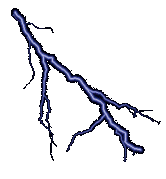





Switzerland received a black rain on January 20, 1911. The Cape of Good Hope experienced on August 14, 1888 "a rain so black as to be described as 'a shower of ink'. ... A correspondent to Knowledge, 5-190, writes of a black rain that fell in the Clyde Valley, March 1, 1884: of another black rain that fell two days later. According to the correspondent, a black rain had fallen in the Clyde Valley, March 20, 1828: then again March 22, 1828. According to Nature, 9--43, a black rain fell at Marlsford, England, Sept.4, 1873; more than twenty-four hours later another black rain fell in the same small town."
The Rev.James Rust states in Scottish Showers that a black rain fell at Slains, Jan.14, 1862 and another at Carluke (140 miles from Slains ) on May 1, 1862. Slains received another black rain on May 20, 1862 and still another on October 28, 1863. Following two of these black rain showers, "...vast quantities of a substance described sometimes as 'pumice stone,' but sometimes as 'slag' were washed upon the sea coast near Slains. A chemist's opinion is given that this substance was slag: that it was not a volcanic product: slag from smelting works. We now have, for black rain, a concomitant that is irreconcilable with origin from factory chimneys" (Fort means this as a refutation of the popular theory that black rains are the sole result of air pollution from the industries of the time.
The first and second rains corresponded, in time, with ordinary ebullitions from Vesuvius. The third and fourth, according to Mr.Rust, corresponded with no known volcanic activities upon this earth." According to La Science Pour Tous "between October, 1863, and January, 1866, four more black rains fell at Slains, Scotland. The writer of this supplementary account tells us, with a better, or more unscrupulous, orthodoxy than Mr.Rust's, that of the eight black rains, five coincided with eruptions of Vesuvius and three with eruptions of Etna." However, this association of the volcanic activity with the black rains of Slain seems a little ludicrous when one considers the situation as "...four discharges from one far-distant volcano, passing over a great part of Europe, precipitating nowhere else, discharging precisely over one small northern parish and three other discharges from another far-distant volcano, showing the same precise preference, if not marksmanship, for one small parish in Scotland."
The indications ...are that perhaps an explosion occurred in the sky, near Colchester, upon Feb.18, 1884; that a great explasion did occur over Colchester, upon the 22nd of April, and that a great volume of debris spread over England, in a northwesterly direction, passing over Worcestershire and Shropshire, and continuing on toward Liverpool, nucleating moisture and falling in blackest of rain. From Stonyhurst Observatory, near Liverpool, was reported, occurring at 11 am., April 26, 'the most extraordinary darkness remembered'; forty minutes later fell rain 'as black as ink,' and then black snow and black hail (Nature,30-6). Black hail fell at Chaigley, several miles from Liverpool (Stonyhurst Magazine).
Five hours later, black substance fell at Crowle, near Worcester (Nature,303-32). Upon the 28th, at Church Stretton and Much Wenlock, Shropshire, fell torrents of liquid like ink and water in equal proportions (The Field,May 3, 1884)." (page 440) This rain was "...so intense that the following day brooks were still dyed with it."(page 31) "In Jour. Roy .Met. Soc., 11-7, it is said that, upon the 28th, half a mile from Lilleshall, Shropshire, an unknown pink substance was brought down by a storm. Upon the 3rd of May, black substance fell again at Crowle.
In Nature, 30-216, a correspondent writes that, upon June 22, 1884, at Fletching, Sussex, southwest of Colchester, there was intence darkness and that rain then brought down flakes of soot in such abundance that it seemed to be 'snowing black.' This was several months after the shock at Colchester, but my datum for thinking that another explosionm or disturbance of some kind, had occurred in the same local sky, is that, as reported by the inmates of one house, a slight shock was felt, upon the 24th of June, at Colchester, showing that the phenomena were continuing. ...Was not the loud report heard upon February 18 probably an explosion in the sky, inasmuch as the sound was great and the quake was little? Were not succeeding phenomena sounds and concussions and the fall of debris from explosions in the sky, acceptably upon April 22, and perhaps continuing until the 24th of June?"


